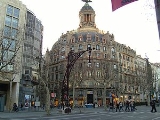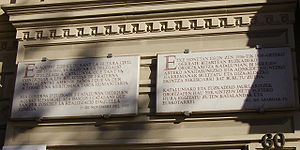
Passeig de Gràcia, Barcelona
Encyclopedia


Barcelona
Barcelona is the second largest city in Spain after Madrid, and the capital of Catalonia, with a population of 1,621,537 within its administrative limits on a land area of...
(Spain
Spain
Spain , officially the Kingdom of Spain languages]] under the European Charter for Regional or Minority Languages. In each of these, Spain's official name is as follows:;;;;;;), is a country and member state of the European Union located in southwestern Europe on the Iberian Peninsula...
) and also one of its most important shopping and business areas, containing several of the city's most celebrated pieces of architecture
Architecture
Architecture is both the process and product of planning, designing and construction. Architectural works, in the material form of buildings, are often perceived as cultural and political symbols and as works of art...
. It is located in the central part of Eixample
Eixample
The Eixample is a district of Barcelona between the old city and what were once surrounding small towns , constructed in the 19th and early 20th centuries....
, stretching from Plaça Catalunya to Carrer Gran de Gràcia. In terms of the cost of renting or buying property anywhere in this avenue, Passeig de Gràcia is nowadays regarded as the most expensive street in Barcelona and also in Spain, ahead even of Calle Serrano in Madrid
Madrid
Madrid is the capital and largest city of Spain. The population of the city is roughly 3.3 million and the entire population of the Madrid metropolitan area is calculated to be 6.271 million. It is the third largest city in the European Union, after London and Berlin, and its metropolitan...
.
History
Formerly known as Camí de Jesús ("Jesus Road"), it used to be little more than a quasi-rural lane surrounded by gardens joining Barcelona and GràciaGràcia
Gràcia is a district of the city of Barcelona, Catalonia, Spain. It comprises the neighborhoods of Vila de Gràcia, Vallcarca i els Penitents, El Coll, La Salut and Camp d'en Grassot i Gràcia Nova. Gràcia is bordered by the districts of Eixample to the south, Sarrià-Sant Gervasi to the west and...
(then still a separate town), until the first urbanisation project in 1821 devised by the liberal
Liberal Party (Spain)
The Liberal Party was a liberal Spanish political party.It was part of the Democratic Centre Union until 1983, when it aligned itself with the Popular Alliance and the Democratic Popular Party...
city council, and led by Ramon Plana, who had to suddenly cancel his work due to the epidemics that were raging in Barcelona at the time.
After the demise of the liberal government with the return of Absolutism
Absolutism (European history)
Absolutism or The Age of Absolutism is a historiographical term used to describe a form of monarchical power that is unrestrained by all other institutions, such as churches, legislatures, or social elites...
in 1824, the project was taken up again by general José Bernaldo de Quirós, marquis of Campo Sagrado. The new avenue was 42 metres wide in 1827 and became a favourite place for aristocrats to display their horse riding skills and expensive horse-drawn carriages all through the 19th century.
In 1906 the architect Pere Falqués i Urpí designed the avenue's now famous ornate benches and street-lights. By that time it had become Barcelona's most fashionable street, with buildings designed by modernista
Modernisme
Modernisme was a cultural movement associated with the search for Catalan national identity. It is often understood as an equivalent to a number of fin-de-siècle art movements, such as Art Nouveau, Jugendstil, Secessionism, and Liberty style, and was active from roughly 1888 to 1911 Modernisme ...
/Art Nouveau
Art Nouveau
Art Nouveau is an international philosophy and style of art, architecture and applied art—especially the decorative arts—that were most popular during 1890–1910. The name "Art Nouveau" is French for "new art"...
architects of fame such as Antoni Gaudí
Antoni Gaudí
Antoni Gaudí i Cornet was a Spanish Catalan architect and figurehead of Catalan Modernism. Gaudí's works reflect his highly individual and distinctive style and are largely concentrated in the Catalan capital of Barcelona, notably his magnum opus, the Sagrada Família.Much of Gaudí's work was...
, Pere Falqués, Josep Puig i Cadafalch
Josep Puig i Cadafalch
Josep Puig i Cadafalch was a Spanish Catalan Modernista architect who designed many significant buildings in Barcelona...
, Lluís Domènech i Montaner
Lluís Domènech i Montaner
Lluís Domènech i Montaner was a Spanish Catalan architect who was highly influential on Modernisme català, the Catalan Art Nouveau / Jugendstil movement. He was also a Catalan politician....
, Enric Sagnier
Enric Sagnier
Enric Sagnier i Villavecchia was a Catalan architect of Spanish nationality.Although now not as well known as his contemporaries Antoni Gaudí, Lluís Domènech i Montaner and Josep Puig i Cadafalch, he was responsible for a number of landmark buildings, was very prolific, and could turn his hand to...
and Josep Vilaseca
Josep Vilaseca i Casanovas
Josep Vilaseca i Casanovas was a Catalan architect and artist who formed part of the Modernista movement.He studied architecture in Madrid and qualified in 1873. He travelled with Lluís Domènech i Montaner in Germany...
.
The government of the Basque Country
Basque Country (historical territory)
The Basque Country is the name given to the home of the Basque people in the western Pyrenees that spans the border between France and Spain on the Atlantic coast....
(Eusko Jaurlaritza) was based in Passeig de Gràcia, 60 during the Spanish Civil War
Spanish Civil War
The Spanish Civil WarAlso known as The Crusade among Nationalists, the Fourth Carlist War among Carlists, and The Rebellion or Uprising among Republicans. was a major conflict fought in Spain from 17 July 1936 to 1 April 1939...
. The Catalan poet
Catalan literature
Catalan literature is the name conventionally used to refer to literature written in the Catalan language. The Catalan literary tradition is extensive, starting in the Middle Ages....
Salvador Espriu
Salvador Espriu
Salvador Espriu i Castelló was a Catalan poet writing in the Catalan language.-Biography:Espriu was born in Santa Coloma de Farners, Catalonia. He was the son of an attorney. His childhood was divided between his home town, Barcelona, and Arenys de Mar, a village on the Maresme coast...
resided in Casa Fuster (Passeig de Gràcia, 132).
Notable buildings
- Illa de la DiscòrdiaIlla de la DiscòrdiaThe Illa de la Discòrdia , is a block on Passeig de Gràcia in the Eixample District of Barcelona, Spain. The block is noted for having buildings by four of Barcelona's most important Modernista architects, Lluís Domènech i Montaner, Antoni Gaudí, Josep Puig i Cadafalch and Enric Sagnier, in close...
- Casa AmatllerCasa AmatllerCasa Amatller is a building in the Modernisme style in Barcelona, designed by Josep Puig i Cadafalch. Along with Casa Batlló and Casa Lleó-Morera, it makes up the three most important buildings in Barcelona's famous Illa de la Discòrdia , noted for its unique modernist buildings.The building was...
by Josep Puig i CadafalchJosep Puig i CadafalchJosep Puig i Cadafalch was a Spanish Catalan Modernista architect who designed many significant buildings in Barcelona...
(1890-1900) - Casa BatllóCasa BatllóCasa Batlló is a building restored by Antoni Gaudí and Josep Maria Jujol, built in the year 1877 and remodelled in the years 1904–1906; located at 43, Passeig de Gràcia , part of the Illa de la Discòrdia in the Eixample district of Barcelona, Spain...
by Antoni GaudíAntoni GaudíAntoni Gaudí i Cornet was a Spanish Catalan architect and figurehead of Catalan Modernism. Gaudí's works reflect his highly individual and distinctive style and are largely concentrated in the Catalan capital of Barcelona, notably his magnum opus, the Sagrada Família.Much of Gaudí's work was...
(1904-1906) - Casa Lleó MoreraCasa Lleó MoreraThe Casa Lleó Morera is a building designed by noted modernisme architect Lluís Domènech i Montaner, located at Passeig de Gràcia 35 in the Eixample district of Barcelona. The building is located on the corner of Carrer del Consell de Cent, and is one of the three important buildings of...
by Lluís Domènech i MontanerLluís Domènech i MontanerLluís Domènech i Montaner was a Spanish Catalan architect who was highly influential on Modernisme català, the Catalan Art Nouveau / Jugendstil movement. He was also a Catalan politician....
(1902-1906) - Museu del Perfum
- Casa Amatller
- Cases Antoni Rocamora by Josep Bassegoda i Amigó (1914-1917)
- Casa Bonaventura Ferrer by Pere Falqués i Urpí (1906)
- Casa Fuster by Josep Puig i CadafalchJosep Puig i CadafalchJosep Puig i Cadafalch was a Spanish Catalan Modernista architect who designed many significant buildings in Barcelona...
(1908-1911) - Casa MilàCasa MilàCasa Milà , better known as La Pedrera , is a building designed by the Catalan architect Antoni Gaudí and built during the years 1905–1910, being considered officially completed in 1912...
"La Pedrera" by Antoni GaudíAntoni GaudíAntoni Gaudí i Cornet was a Spanish Catalan architect and figurehead of Catalan Modernism. Gaudí's works reflect his highly individual and distinctive style and are largely concentrated in the Catalan capital of Barcelona, notably his magnum opus, the Sagrada Família.Much of Gaudí's work was...
(1905-1910) - Casa Pons i Pascual by Enric SagnierEnric SagnierEnric Sagnier i Villavecchia was a Catalan architect of Spanish nationality.Although now not as well known as his contemporaries Antoni Gaudí, Lluís Domènech i Montaner and Josep Puig i Cadafalch, he was responsible for a number of landmark buildings, was very prolific, and could turn his hand to...
(1891) - Casa Ramon Casas by Antoni Rovira i Rabassa (1898)
- Palau RobertPalau RobertPalau Robert is a building on Barcelona's Passeig de Gràcia 107, the former private residence of Robert Robert i Surís, an influential aristocrat, politician and businessman at the turn of the 20th century...
(1903)
- Teatre Tívoli
- Jardins de Salvador Espriu
Transportation
- Passeig de Gràcia (Barcelona Metro)Passeig de Gràcia (Barcelona Metro)Passeig de Gràcia is an underground railway and metro station in Barcelona located under Passeig de Gràcia, in Eixample district. It is one of the Barcelona's busiest railway stations and important stop for Barcelona Metro network...
- Diagonal (Barcelona Metro)
- Passeig de Gràcia train station
- Bus
See also
- EixampleEixampleThe Eixample is a district of Barcelona between the old city and what were once surrounding small towns , constructed in the 19th and early 20th centuries....
, List of streets in Eixample - Ildefons CerdàIldefons CerdàIldefons Cerdà i Sunyer was the progressive Catalan Spanish urban planner who designed the 19th-century "extension" of Barcelona called the Eixample.-Biography:...
- GràciaGràciaGràcia is a district of the city of Barcelona, Catalonia, Spain. It comprises the neighborhoods of Vila de Gràcia, Vallcarca i els Penitents, El Coll, La Salut and Camp d'en Grassot i Gràcia Nova. Gràcia is bordered by the districts of Eixample to the south, Sarrià-Sant Gervasi to the west and...
- ModernismeModernismeModernisme was a cultural movement associated with the search for Catalan national identity. It is often understood as an equivalent to a number of fin-de-siècle art movements, such as Art Nouveau, Jugendstil, Secessionism, and Liberty style, and was active from roughly 1888 to 1911 Modernisme ...
, Art NouveauArt NouveauArt Nouveau is an international philosophy and style of art, architecture and applied art—especially the decorative arts—that were most popular during 1890–1910. The name "Art Nouveau" is French for "new art"... - NoucentismeNoucentismeNoucentisme was a Catalan cultural movement of the early 20th century that originated largely as a reaction against Modernisme, both in art and ideology, and was, simultaneously, a perception of art almost opposite to that of avantgardists...
- BarcelonaBarcelonaBarcelona is the second largest city in Spain after Madrid, and the capital of Catalonia, with a population of 1,621,537 within its administrative limits on a land area of...

